I am lucky to live close to the river; and when I say close, I mean it: 167 steps total. Yes, I've done my counting! I see the Vistula every day and enjoy the view. Whenever I look at the stream I see the past with a beach sprawling below the Wawel Hill, people wearing retro swimsuits, beach volleyball players enjoying the game, and giggling kids dabbling in water. Perhaps the day will come when I can spread my blanket on the sand and put my feet in the crystal clear river.

Looking back into the Vistula’s past
It's been more than fifty years since the river was tamed within the borders of the city. The old Vistula - untamed, capricious, and wild - can now be seen only on photographs. When the construction of the Dąbie tidal barrage began in 1957 it was just a matter of time before the river level would increase drastically. Today, when I think about the Vistula of the old days I remember a song my grandpa used to sing to me. With its doggerel verses, the song embodied the beauty of the river in its story of the Vistula flowing through the Polish land and falling in love with the city of Kraków.
Speaking of old photographs, let's now take a look at some of them. In the past, the Vistula was a popular destination among Kraków residents seeking rest and relaxation. Long and sandy beaches on both sides of the river attracted bath-thirsty city crowds. After putting on swimwear in one of the wooden cabins, kids flocked around an ice-cream cart while men, peeking at women enjoying a swing, exhibited their muscles with pride. Needless to say there was no beach time without a picnic basket!


Beach at the Vistula, 1960s. photo: H. Hermanowicz. Historical Museum of the City of Krakow

Water Critical Mass
Beach at the Vistula, 1960s. photo: H. Hermanowicz. Historical Museum of the City of Krakow
Water Critical Mass

Beach at the Vistula, 1926
Beach at the Vistula, 1926
The postwar years weren't much different in a sense that the Vistula continued to be the place where you went for a walk, sunbathed, played football, and flirted with your crush. The river itself, however, was left neglected. Exploited and dirty, it started losing its appeal. Beaches, raftmen, and beachgoers were gone. Today, we keep trying to bring back the past and restore the beauty of the Vistula so that it can be given back to the people. A living proof of this effort is *Wodna Masa Krytyczna / Water Critical Mass - an annual event held at the end of June, bringing together hundreds of participants who swim the Vistula on weird installations, colorful amphibians, canoes, and boats, reminding us that the river used to be the epicenter of life - the source of joy and fun for the locals. With that in mind, let's walk along the two banks and relive the past.
The right bank
We set out in a recently opened Dębnicki Park with its adjacent Lasocki Palace. Plentiful picturesque alleys and trees provide plenty of space where you can take a break and have a snack before the trip. This fragment of Vistula Boulevards attracts the sun for the most part of the day and offers sunsets with a truly Instagram potential. Located on the right side of the park is Dębniki, a district known for its eclectic villas dating back to the interwar period and the 1960s. In the heart of the place there is a tiny square surrounded by low tenement houses boasting a variety of delicious food spots: Zaczyn - a vegan bakery with exquisite breakfasts and naturally-leavened bread; Lodowy Warsztat with craft ice-cream and Pierogarnia serving traditional pierogies, including a summertime-only, strawberry option hidden under heaps of whipped cream. Next, we go past Dębicki bridge where the river meanders scenically around Wawel Castle. If you're lucky, you may set foot on the only true beach in the city appearing annually on this side of the river. Unfortunately, it's also annually swallowed by dredgers, metaphorically falling prey to the Wawel dragon. The vicinity of the bridge is where locals like to picnic, relishing the view and the shade of old trees. Going further, we reach Manngha Centre - a museum devoted to Japanese art collected primarily by Feliks Manngha Jasieński. One of the integral parts of the museum, apart from the Andrzej Wajda Archive and a Japanese Language School, is Europe-Far East Gallery, featuring breathtaking exhibitions of broadly-defined art, culture, and technology from the Far East. The gallery is located in a building completed in 2015. Designed by Arata Isozaki, the building beautifully fits into the landscape of the Vistula without interrupting the well-established genius loci. The terrace on the Wawel Hill offers a one-of-a-kind view on the building. I love taking a short footbridge to the museum terrace and, at Cafe Manggha, drink a cup of Japanese tea brewed by Murat the tea pairing master. With an adorable tea bowl from Andrzej Mędrek's ceramics studio in my hands, I like looking at the other side of the river. Just like that.

Cafe Manggha, view from the terrace at Wawel
Cafe Manggha, view from the terrace at Wawel

Zaczyn

Muzeum Manggha
Zaczyn
Muzeum Manggha
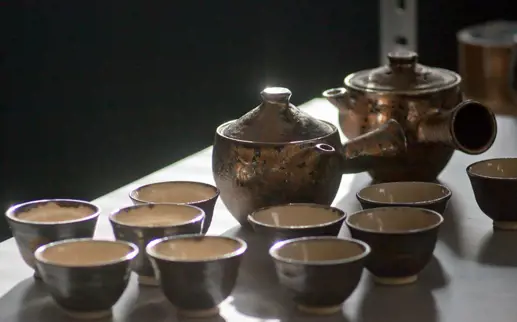
Andrzej Mędrek's ceramics
Andrzej Mędrek's ceramics

Pierogarnia
Pierogarnia
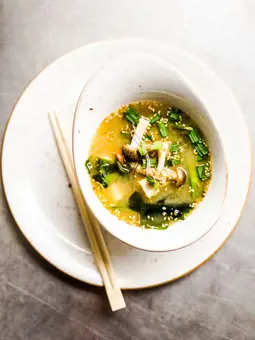
Cafe Manggha

Cafe Manggha
Now, having eaten some Japanese treats, we're walking under Grunwaldzki bridge. Hotel Forum springs up in front of our eyes. This iconic 1980s building used to be the most modern of Polish hotels, boasting four stars, 278 rooms, air conditioning as well as automatic doors and toilet flushes and a two-story parking with an elevator. If this weren't enough, there was a digital clock on the facade giving you not only time, but the temperature and the date as well! Nowadays, well-kept banquet rooms are used for various festivals and fairs while the ground floor houses Forum Przestrzenie - a laid-back clubbing space with original cuisine from Max the chef, quite an impressive line-up and pizza served all night long.
A curious fact about Kraków is that it actually has six rivers flowing through it and one of them is the Wilga. Meandering inconspicuously in its rather thin bed through residential areas, meadows, and allotments, it eventually flows into the Vistula. We cross the Wilga as we enter a tiny Retmański bridge behind the hotel. Built in 1938, the bridge bears the name that refers to the profession of a "retman" - an experienced raftsman in charge of an entire expedition, including the condition and transportation of rafts. We've now reached Podgórze, a district known for a Jewish ghetto that used to be located nearby and whose remains can be seen near the Ghetto Heroes Square (Plac Bohaterów Getta). A charming Bednarski Park and Krakus Mound are only a short walk away from us, but we go past Piłsudski bridge to reach a bike/pedestrian bridge called Bernatka. You can go down the stony stairs to Józefińska and eat a delicious dinner in Zakładka specializing in French cuisine or go a bit further to oriental Vietnam and enjoy a pho soup or shrimps fried in green rice. After dinner, go and taste spectacular ice-cream from Emil kręci lody and meet Emil in person or simply continue your walk along the boulevards to Cricoteka - a museum, gallery, and research facility devoted to a renowned Polish artist, Tadeusz Kantor. The museum cafe located on the top floor offers a wonderful view of the Vistula, Kazimierz, and Podgórze. Follow the river to Zabłocie and finish the trip with a visit to MOCAK - the Museum of Contemporary Art - with its world-famous building, Schindler's Museum, or go to Krakó Slow Wines winery on Lipowa 6F if you should fancy a glass of exquisite, organic wine.

Hotel Forum, bird's eye view
Hotel Forum, bird's eye view

Max, Forum Przestrzenie

ZaKładka
Max, Forum Przestrzenie
ZaKładka

Max, Forum Przestrzenie
Max, Forum Przestrzenie

Cricoteka Cafe
Cricoteka Cafe

photo: Cracow By Drone
photo: Cracow By Drone
The left bank
The left bank is where I live - in the Kazimierz district, to be more precise - but we're beginning our escapade a bit earlier, in Salwator, where, near St. Norbert's Convent, a different picturesque river, the Rudawa, flows out of the Vistula. Were we to follow its run, we would end up in Błonia, the largest meadow in the heart of Kraków. A beach and a haven used to be here, too, but what's left is a sandy bank and, once again, old pictures. According to Krzysztof Jakubowski "Before the war, the stony slope below the Convent was covered in a layer of calcareous sediment with an original souvenir from the Miocene - a fossilized set of oysters and scallops." If you look across from the Convent, you will see Lasocki Palace and Dębnicki Park - the starting point of our first walk.
Jubilat shopping mall - an iconic example of Communist architecture built in 1969 - is commonly accepted as a point where Salwator ends and the Old Town begins. Having popped up at the intersection of Aleja Trzech Wieszczów and Zwierzyniecka, this modernist building was the biggest shopping mall in Krakow for three decades following its opening. To this day, the place enchants with its unchanged architecture and views afforded by Restauracja Vidok and Cafe Oranżeria. Located high in the sky, both cafe and a restaurant offer a view of the Vistula and a proud silhouette of Wawel. I recommend having a coffee with a view at any time of the day! We're now close to one of Kraków's finest jewels - Wawel Castle - but I won't be going into detail since it has already been described in ways that do it much more justice. Let's walk below Grunwaldzki bridge and choose one of the two viewing spots (upper or lower one) at Inflacki Boulevard. In the distance you can see a dazzling, white Baroque silhouette of the Pauline Monastery on Skałka, a national pantheon I've already written about in a guide to Kazimierz. Enjoy your time by simply lying on the grass eating delicious sandwiches from a nearby breakfast spot Ranny Ptaszek or reveling in Indian snacks from a charming restaurant Hello India.
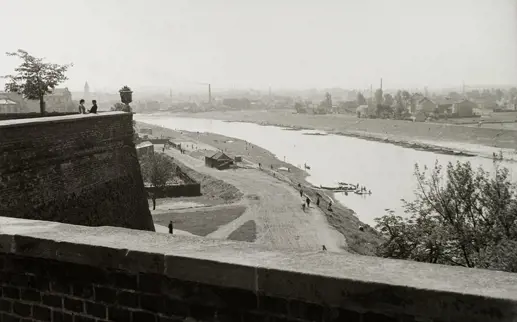
Around Wawel, 1934
Around Wawel, 1934

Cafe Oranżeria
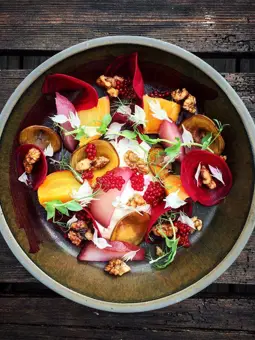
Barka
Cafe Oranżeria
Barka

Barka Alrina
Barka Alrina
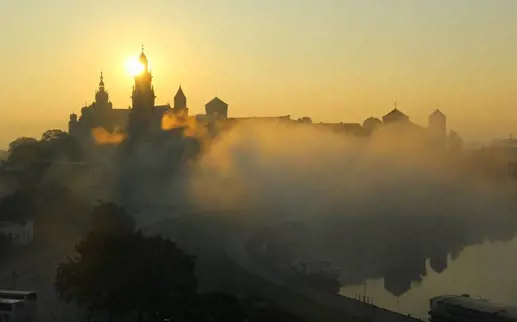
The view from Vidok Restaurant
The view from Vidok Restaurant
Walking alongside old maples that provide you with shade in summertime and abundance of color in autumn is truly wonderful. We reach Piłsudski bridge - I like to call it our Kraków Eiffel Tower due to its steel construction and similar riveting. I wonder if it's actually a good thing that it took seven years to complete it, since it has been the oldest street bridge over the Vistula in use up to now. Here we can take Krakowska or walk deeper into the Kazimierz district and cross the beautiful Wolnica Square (I wrote about it here). The third option is to go even further and avoid passing Bernatka footbridge and experiencing the touristy Miodowa street - even though it's worth paying a visit to Barawino for some good wine and local snacks including traditional pretzels with bryndza. When you go down to Kurlandzki Boulevard, you'll see Barka Alrina - a Dutch, 55-meter-long and 130-year-old beauty (one of the three that can be seen in Europe) - where you can get a refreshing cocktail on a hot day and enjoy the dancefloor in the evening while looking at the moon and Cricoteca looming in the distance. Take Gazowa - a pub-free, quiet, and elegant street - to reach Wawrzyńca, so that you are only a few steps away from the heart of Kazimierz: Nowy Square (Plac Nowy) and adjacent Szeroka street. I'm leaving you here, at Wawrzyńca, a paved street that knows no passing of time. You can still see a building of a power plant, dating back to 1904, which for the first time lighted the streets of Planty in 1913. Remember to take the same route via the river, in the summer. Use a water tram or a boat and enjoy a completely different perspective of the two sides of the Vistula with surrounding bridges, buildings, and historic sites. The Vistula is beautiful!
tekst: Kasia Pilitowska
heading photo: Cafe Oranżeria
Similiar Articles

- Trend
- Art
- People
- News
- Poland
Bielska Jesień – interview with Ada Piekarska, curator of poland's premier painting competition

- Trend
- News
- Poland
Urban Jungle – a children's book published by PURO
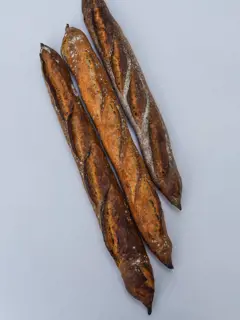
- Trend
- News
- Poland
